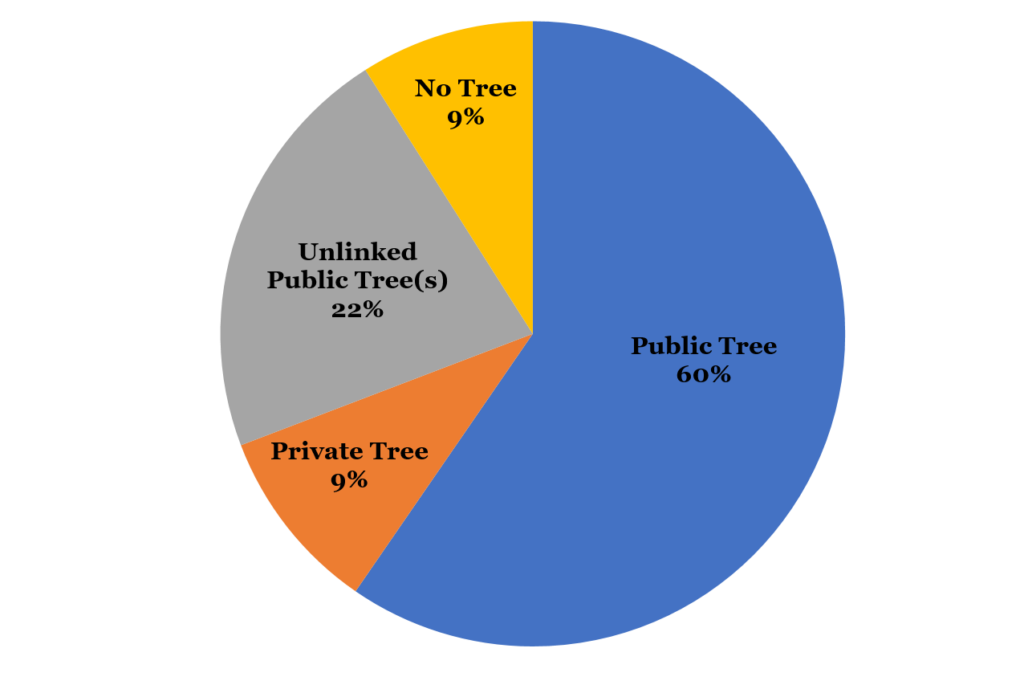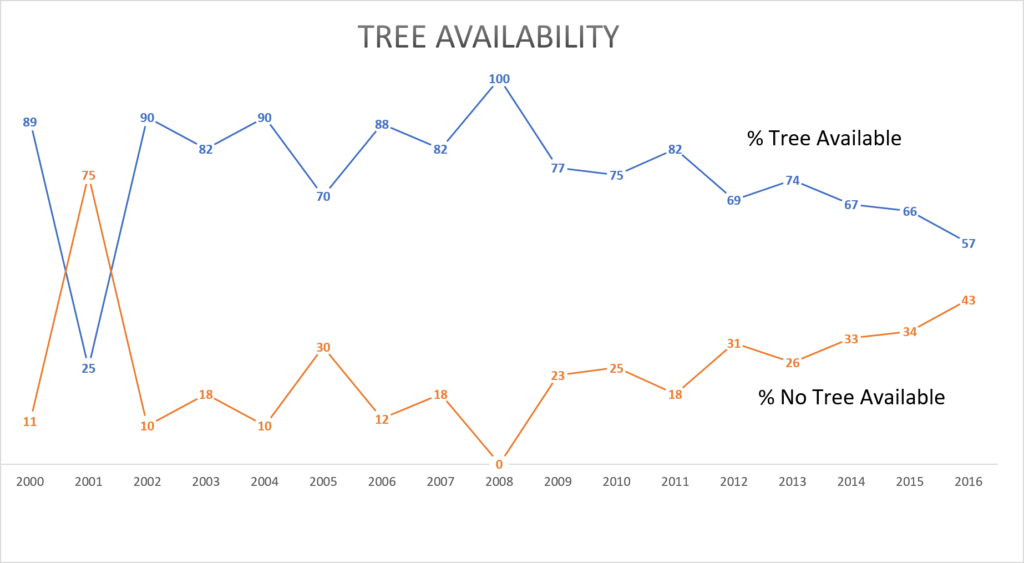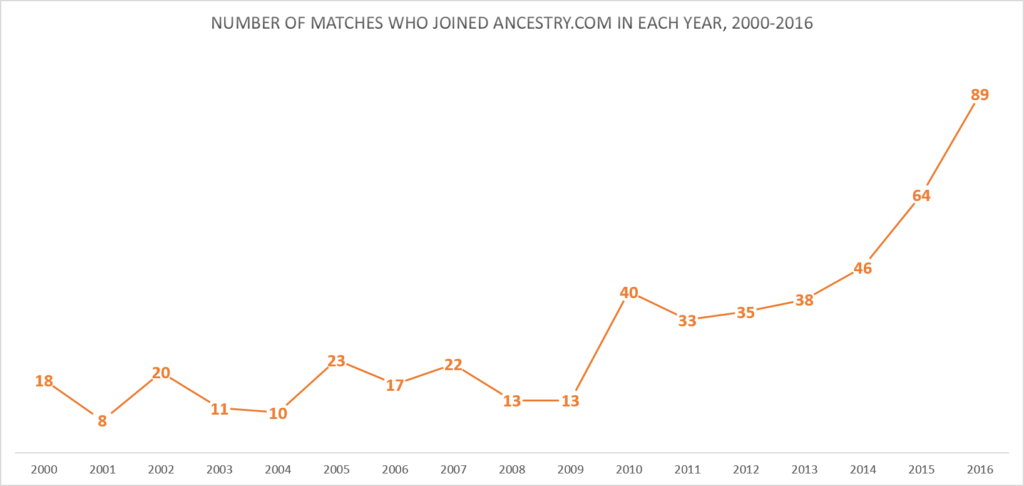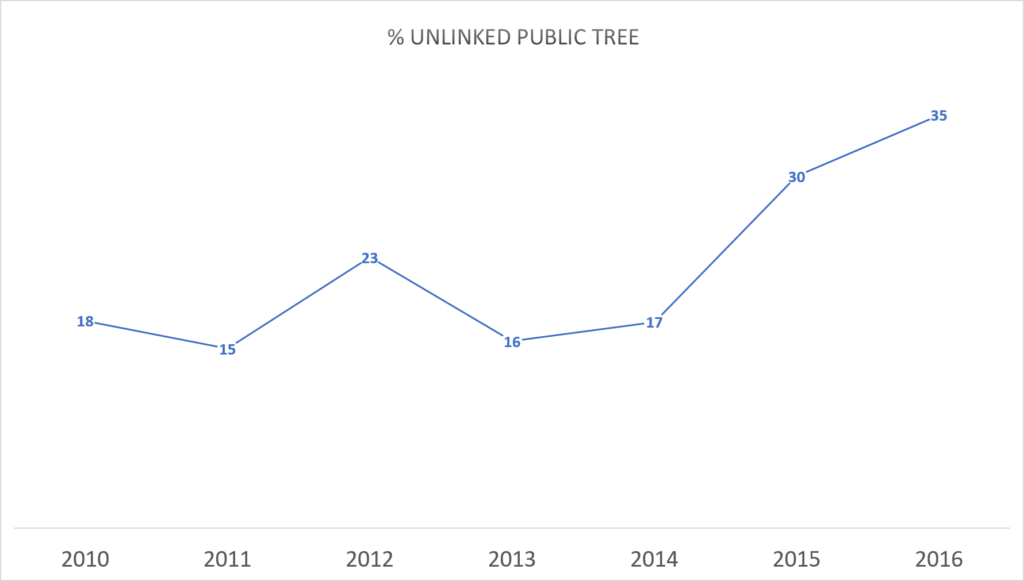Last week, AncestryDNA announced that their database has reached 3 million people, and that they had sold 1.4 million kits on top of that in the last 3 months of 2016. See “Ancestry Sets AncestryDNA Sales Record Over Holiday Period and Fourth Quarter” for more information.
This means that by summer or fall of 2017, the database is likely to reach 5 million people.
Many people have noted that many of these new test-takers will undoubtedly not have trees. That’s true, unfortunately, although it is a challenge rather than an absolute roadblock. It is an opportunity for experienced genealogists to engage new genealogists and encourage and help them. Indeed, many of them will never add a tree, and that will be very, very frustrating. But at least a small fraction of those will have a good reason for not doing so. The majority without trees will likely either not know how to do it, or may only be interested in ethnicity.
What I find surprising, however, is that there are any complaints about all the new test-takers at AncestryDNA! You can’t get new test-takers WITH trees attached unless you get a lot of new test-takers. To me, the growth of the database can only help me.
Must Read!
Now, before you read this post, you MUST read this post from Kerry Scott about new test-takers at AncestryDNA: “Genealogy Changed Dramatically in 2016. I Can Prove It.” You won’t regret it!
Also, I suggest reading “Let’s Stop Hand Wringing About DNA and Genealogy” from Amy Johnson Crow, which mentions the lamentation that is heard when anything about many new test-takers is mentioned.
Then come back and read this post.
Who Has Attached Trees at AncestryDNA?
Although there has been a lot of discussion of newbies not having trees, I have not seen much or any quantification of tree availability for test-takers at AncestryDNA. Accordingly, I wanted to know how many of my genetic matches have trees, and whether there is a relationship between the year they joined Ancestry.com as a member, and the likelihood of having a tree.
Approach #1 – A Rough Glance
I took everyone at or above my self-imposed safety threshold of 10 cM (with a 94% probability of being real matches, see “The Danger of Distant Matches”), and I removed the people that I had tested myself and linked to my own tree. That turned out to be 4,176 matches.
Of the 4,176 matches, a total of 2,473 matches (59.2%) had some tree attached. I analyzed this by downloading my matches using the DNAGEDcom client. Unfortunately, I couldn’t tell which trees were locked and which matches had a tree available but not attached to their DNA results.
So, this very simplified approach suggests somewhere around 60%, although it is likely to be extremely inaccurate for two reasons: (i) a profile will report as having a tree attached to the DNA even if that tree is private; and (ii) many profiles have public but unattached trees, and these profiles do NOT report as having a tree attached.
Approach #2 – A Detailed Review
To perform this analysis with greater detail, I looked at each of my 500 closest matches, skipping over those that I had tested myself. This allowed me to determine when the match joined Ancestry, whether an attached tree was public or private, and whether the match had an unattached tree for review. I would have liked to do 1,000 matches or even all my matches, but there were time constraints. So keep in mind that the data set is on the small side.
Tree Availability for my first 500 matches:
- 298 matches (60%) had a public tree linked to their DNA;
- 48 matches (9%) had a private tree;
- 109 matches (22%) had one or more public trees unlinked to their DNA;
- 45 matches (9%) had no tree at all.
So this meant that 82% (60% Public Tree + 22% Unlinked Public Tree(s)) of my first 500 matches had some tree available to review, and 18% (9% Private Tree + 9% No Tree) had no tree to review.
Now I know there are lots of caveats here. For example, you can contact people with private trees to ask if they might be willing to share. As another example, who knows which of those unlinked public trees might be the right one. But at least there is something, which is better than nothing.
Additionally, I did not quantify the size of the attached tree, so some of the trees could have been very small. However, my biggest breakthrough at AncestryDNA came from a tree with just 3 people in it, so I think tree size is an issue but usually not an insurmountable problem.
Year of Joining and Likelihood of Having a Tree
For my first 500 matches, there was a relationship between the year someone joined AncestryDNA, and the likelihood that they have some tree available (“available” means either a public attached or unlinked tree). As we might predict, the more recently someone has joined AncestryDNA, the less likely they are to have a tree available:
What surprises me, however, is how many people DO have some tree available, even recent members (who are probably recent DNA test-takers). For people who joined in 2016, 57% of them had some tree available for me to review.
Not surprisingly (see Kerry’s post above), many of my first 500 matches joined AncestryDNA in the past few years:
Another interesting pattern that emerged from the data was the percentage of test-takers that had one or more public trees that were not yet linked to their DNA. These trees are public and available for matches to review, but are not directly tied to the test-taker.
The results suggest that although MANY new 2016 members of AncestryDNA do in fact have public trees in their profiles, they haven’t linked them to their DNA results. Indeed, 35% of these 2016 new member matches had a tree they hadn’t yet linked to their DNA:
This is an example of a great opportunity for genealogists. Explaining to new matches the benefits of having a public tree attached (DNA Circles, facilitating review by your matches for finding connections, etc.) could convince them to attach their tree.
Conclusions
I don’t know how much I learned from this exercise, but it is food for thought. Based on my first 500 matches, many new 2016 members (57%) do have some form of tree available for review. Although it is the lowest percentage by year for the past 15 years, maybe there is reason for hope. As time goes one, perhaps that number will increase. Indeed, it will be interesting to follow the 89 matches who joined in 2016 to see if the percentage of tree availability increases.
I also learned that many new 2016 members (35%) have a tree but have not attached it to their DNA. This is an easy opportunity for genealogists to help new member, and/or to explain the benefits of an attached tree.
It’s good to have some quantifiable data, rather than anecdote, which is too easily biased. I’d love to do this for all my matches, or even better have this data for everyone in the database, but this will have to do for now.




These results really surprised me. Anecdotally I would have thought the percentage of my matches having trees was much lower. So I can help myself by routinely looking for those unattached trees. I’ve been involved in genetic genealogy for over a decade and it is helpful to see the field from another set of eyes. Great post!
I agree, I didn’t expect the percentage to be so high. This is, of course, a very small data set, but several others have reviewed their matches following this post, and have found similar numbers.
Thanks for this article. Informative and important.
Do you think Ancestry users know how to attach their trees to their DNA results. (I unattached mine at one point, and it was difficult navigating the site to get it re-attached.)
Ancestry is great at getting the word out about its DNA tests. Does ancestry request that new users who’ve taken their DNA test upload a few names to add to a tree when the new users without trees get their results back?
I think that helping Ancestry users learn how to attach trees to their DNA results is an important area for improvement!
I totally agree! I have been researching for over 20 years and have 30,000+ individuals in my database; 2 years ago I sent in my DNA kit. I received my results but no instructions on submitting my trees. Perhaps the reason for no information is that I am not a “member” because I access Ancestry.com through the university from which I retired 14 years ago????
I wonder if many of the people who test do so, not because they have time/interest at the present time to pursue genetic genealogy; but instead because it is akin to buying a book they want to read at a future time. It is at hand when they get around to it……..
At Ancestry, I have over 20,000 matches. Only ~20-25% have trees.
Unfortunately, the only way to tell how many matches have trees is to open every profile. I would have loved to have done that, but that would take days.
Hi Blaine Bettinger
This is exiting news.
May I ask if you know the size of Familytreedna data base?
No, I don’t know, that’s not information that they make available.
I find that many of those without trees are adoptees; many know one parent but not the other; many don’t care about genealogy and have tested only because someone asked them to. I am especially surprised by the number of people who match me and, whether or not they have well developed trees, do not respond even when I supply some information to augment their trees. The bottom line seems to be that people are unpredictable and very few are dedicated (read that addicted) like we are.:-)
Yes, it’s frustrating! The good news is that as the database grows, the number of people interested and willing to cooperate will only increase!
One thing I have found is that the ancestry messaging system leaves something to be desired. I think many users don’t know they have messages. ONe gentlemen who I was especially eager to contact didn’t respond. So after a month, I sent a snail mail letter (I was able to determine an address via google based on user name, profile, and family tree). He was so excited to get it that he telephoned me! But he had not seen the ancestry message.
The number of my DNA matches has also exploded recently and at least half appear to be newbies who do not have trees. Those of us who have been at this long enough to have developed large biceps from turning the microfilm handle could help by scanning the paper documentation of our own research and attaching it to our online trees. Perhaps we could make our private trees public so that the newbies are copying our well documented research. We could make time to send them emails and then answer.
Absolutely, working with matches is just as much our responsibility as theirs, and in some ways it is MORE our responsibility. We have the knowledge and we should share that with our matches. Great points!
I dont have your fortitude, so I only surveyed my top 4 pages or 200 matches. My goal was 500 to equal yours, but I began to fear the “No Family Tree” labels….
by %
42 % Public
7 % Private
25 % UnLinked Trees
26% No Trees
So I am dealing with less Public and more No Trees than you. Private and Unlinked are about the same. There was some variation in my 4 pages, with the only clear trend so far was the number of Public decreased considerably over 4 pages (27 to 21 to 19 to 16). But perhaps that would change if I did the full 500.
I also checked one page that was Sorted by Date. So my 50 newest matches. Only 15 Public Trees( 2 Private) but of the 33 No Tree Available, there were 20 UnLinked. So that surprised me that 15 + 2 +20 New Matches actually have a tree of some sort.
So this has shifted my emphasis. The problem is not really Private Trees or even No Family Tree. Really the biggest, most immediate help would be to just get the UnLinked people to attach their tree.
Of course some trees are worthless or nearly so. Trees as low one to three people, and some of them are marked Private as well. But most trees have a reasonable number of people to start with.
Thank you, Blaine!
You have helped me change my perspective on this explosion of new DNA testers. I certainly was one of these saying ‘they are only curious about their ethnicity’! Or, those that do have a tree and don’t link it or make it private are just “hoarding all their hard genealogical work”! Well the latter attitude I have from a sibling who has been researching the French side of our family for many years! 🙂 “Let them do their own research the hard way like I have done all these years”!
I took my first atDNA test through Ancestry in 2015, and right from the start, I was hooked! I check for new matches every day! And now I’ve purchased the full package kit from FTDNA. And purchased a YDNA67 + atDNA for my first cousin, Bill! This since I watched all five of your DNA Webinars at Legacy Family Tree! (Also just received a copy of your book, Guide to DNA Testing and Genetic Genealogy, a great source of DNA info and great reference book).
I hope DNA will help break down some “Donauschaben” brick walls! Well, when most if not all civil and church records for ethnic Germans in the former Austria Hungary Empire were destroyed during and after WWII, what else can you do? I’ve found so many errors in other material, such as OFBs etc and don’t trust them. Someone told me “DNA doesn’t lie”! Hmmmm.
Anyway the first thing I do at Ancestry DNA with new matches is write notes in the note field, how manyy cm and segments, what shared matches they may have with me and my syblings. If they have trees I often can place them in groups of Germans, Norwegian, French and Irish. Sometime I can group them by surname. If I have any surnames connected with a match i sometimes do my own research on the family and if I’m lucky I find where the match is.
From my experience with Ancestry, I have to say I have not had a high % of replies to messages sent.
It certainly would be nice if we had more tools available for those 3 million testers, like some of those at GEDmatch!
Thanks again for sharing for your knowledge and inspiration!
Kind regards,
Kelly
As someone with a private tree on ancestry (currently), I do want to note that there are valid reasons someone’s tree might be private. For some people, perhaps especially adoptees, there may be information on the tree that they just don’t want to be public for personal reasons. There may be some, like a previous poster suggested, who don’t want to give away their hard work. But for me, my ancestry tree is a working tree, with some speculative lines on it to see if in fact DNA can prove those links. I will invite someone who asks, and I have a fully documented public tree on worldconnect at rootsweb. But I don’t want the speculative tree copied 150+ times because a beginner didn’t yet understand the value of sources and documentation. I want to at least be able to tell them some lines aren’t proven before inviting them to view it.
Yup, for sure! There are lots of reasons!